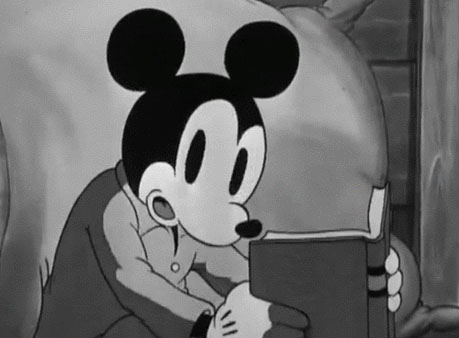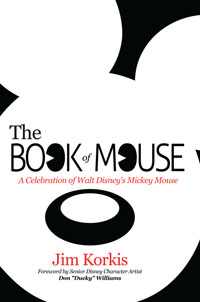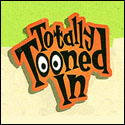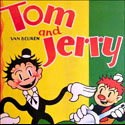
This post is an unabashed plug for Jim Korkis’ latest book. I can’t resist, as Jim has done it again. His newest book was just released to celebrate Mickey Mouse’s 85th birthday – entitled The Book of Mouse, it’s now available on Amazon, and it covers Mickey’s history in the movies, at the Disney theme parks and so much more.
As you know, Jim is an internationally respected animation historian who writes the weekly Friday Animation Anecdotes column for Cartoon Research. Along with co-author John Cawley, Jim authored several books about animation in the early 1990s and in the last few years has written several Disney related books. We had a chat recently about the new project – and what else is going on in the Jim Korkis universe:
 Jerry Beck: Jim, thanks for taking a moment to talk about your newest book.
Jerry Beck: Jim, thanks for taking a moment to talk about your newest book.
Jim Korkis: We both started writing about animation history at the same time and appeared in most of the same publications. It is frightening to realize that we have been writing about animation longer than some of today’s younger animation fans have been alive.
Beck: Don’t remind me. Why did you decide to write a book about the life and career of Mickey Mouse?
Korkis: Probably for the same reasons you and Will Friedwald wrote your groundbreaking book on Warner Cartoons that is still the primary reference today. I just couldn’t find the information I needed about Mickey Mouse, certainly not in a single location, and trust that it was accurate. Even today on the internet with all the resources available, there are horrendous errors about Mickey that are accepted as the truth. So, selfishly I wanted a reliable resource book with all the information so I didn’t have to go digging through dozens of books, magazines, websites and films.
Beck: What is in the book?
Korkis: Well, at over three hundred pages, I wanted to organize it so that I could find things quickly. There are several major sections and each section has sub-sections or chapters or both. Here’s a run-down of the sections:
Mouse-ce-llaneous covers where Mickey lives, how tall he is, who Ub Iwerks was, an exclusive interview with Floyd Gottfredson, the birth of Mickey mouse merchandising, the history of Mickey radio show, the history of the comic strip and more.
Mouse-ka-Tales is twenty pages of Mickey Mouse anecdotes just like the ones I do for Animation Anecdotes but these are solely about Mickey. They cover stories about memorabilia like the Mickey Mouse watches. It was comedian Bill (“Jose Jiminez”) Dana’s watch that was the first Mickey Mouse watch in outer space. Mickey in books. Mickey Milestones like being the Grand Marshal of the Rose Parade. And so much more.
Mickey at the Movies has individual chapters on the making of Plane Crazy, Steamboat Willie, Runaway Brain, Sorcerer’s Apprentice and more like UnMade Mickey Mouse cartoons, Mickey’s Oscar appearances, etc. In addition, I threw in another ten pages of anecdotes just about Mickey’s cartoons.
Mickey Mouse Annotated Filmography includes a listing of every Mickey Mouse theatrical film (including ones for other studios and cameos) and Mickey’s television appearances. I included additional notes with each entry like Purv Pullen doing the tweeting for the canary in The Wayward Canary (1932), which cartoon featured the first pie-eyed Mickey in animation, which cartoon was inspired by Walt getting a traffic ticket, which cartoon has framed, autographed photos of Doug Fairbanks and Mary Pickford, etc.
Mickey at the Parks covers the Mickey Mouse attractions, the history of the Mickey Mouse costumed characters, the biography of the first performer to play Mickey at Walt Disney World as well as the performer who was handpicked by Walt to play Mickey at Disneyland for over twenty years, Mickey Mouse ears and more.
Speaking of the Mouse is almost twenty pages of quotes about Mickey from celebrities like astronaut Buzz Aldrin to animators like Ward Kimball. The quotes cover everything from how difficult it is to animate Mickey to how Walt resembled Mickey
Final Word: Walt on Mickey is ten pages of quotes by Walt about Mickey that don’t appear elsewhere in the book.
Beck: That covers a lot of ground.
Korkis: But I still have chapters I couldn’t squeeze in like Mickey’s history in videogames and comic books. If this book sells well, I have enough for a sequel without repeating anything in this particular book.
Beck: So who is the primary audience for this book? The hard-core Disney researcher or, for lack of a better term, “normal people”?
Korkis: Both. As always, I wrote it so that the casual reader who just wants to look up the name or information of his favorite cartoon can find it and maybe be exposed to some other great stories as well. In addition, it is for that Disney expert who thinks he knows everything about Mickey Mouse. As best I could, I documented my sources so this material can be used elsewhere with confidence. I think everyone who loves Mickey Mouse will find something to enjoy.
Beck: Cartoon characters come, cartoon characters go. What makes Mickey such a survivor?
Korkis: I think its because everyone loves Mickey Mouse, and can identify with him – or at least some version of him. Whether it’s the heroic Mickey in the Gottfredson comic strip or the entertainer Mickey in the early black and white animated shorts, or the costumed character at the parks. I think Mickey is the character that all other characters are measured against in a variety of categories from design to craftsmanship to appeal to marketing to so many other areas. Mickey is still number one after over eight decades. He has had his ups and downs but he survives where others eventually fade.
Jerry: What’s your favorite Mickey Mouse cartoon – and why?
Jim: Great question! My answer might change depending upon the day or my mood but one cartoon that I always love is Two Gun Mickey (1934). It’s just Mickey, Minnie and Pete and no singing and dancing like so many of the early cartoons. As a kid, I was a big fan of cowboys like Roy Rogers and so the first time I saw Mickey as a cowboy hero with blazing six guns, I was instantly captivated. As I grew older, I loved watching to see if I could catch all the times Pete keeps switching his peg leg to a different leg like when he jumps on the fallen log.
Beck: Now you also have another book out as well for the holiday season, The Vault of Walt : Volume 2.
Korkis: Yes, it was just an amazing coincidence that the two books came out a month apart. I have been working on The Book of Mouse for years and it was especially difficult because new things are constantly appearing like just this month a new theatrical short and more episodes of the Disney Channel series.
The Vault of Walt: Volume 2 I started working on last year when The Revised Vault of Walt came out and did so well. As I toured the country for book signings and presentations, people always asked when the next volume would come out. In this latest volume, I think people most enjoy the story of the battle between author P.L. Travers and Walt Disney during the making of Mary Poppins. Mary Poppins is celebrating its 50th anniversary. Boy, do I feel really, really old. Of course, the much anticipated Saving Mr. Banks is going to be released as well so maybe that is why people enjoy that chapter so much.
Beck: Are you working on any other books?
Korkis: Yes, I am compiling material of The Vault of Walt: Volume 3 and I am working on a book that compiles some of the animation anecdotes from my column for you, some anecdotes from magazines columns I have written in the past and some new anecdotes. With any luck that book may be out as early as Spring.
Beck: Thanks, Jim. I value your research and books – and speaking for all the Cartoon Research readers, we love your weekly anecdotes here.
Korkis: My pleasure, Jerry. I hope readers will consider asking Santa to put any of my books on the stocking stuffer list this holiday season. That would certainly help make it a Merry Christmas for me.
You can order The Book of Mouse and The Vault of Walt: Volume 2 online through Amazon – or directly from the publisher Theme Park Press.


 Jerry Beck is a writer, animation producer, college professor and author of more than 15 books on animation history. He is a former studio exec with Nickelodeon Movies and Disney, and has written for The Hollywood Reporter and Variety. He has curated cartoons for DVD and Blu-ray compilations and has lent his expertise to dozens of bonus documentaries and audio commentaries on such. Beck is currently on the faculty of CalArts in Valencia, UCLA in Westwood and Woodbury University in Burbank – teaching animation history. More about Jerry Beck [
Jerry Beck is a writer, animation producer, college professor and author of more than 15 books on animation history. He is a former studio exec with Nickelodeon Movies and Disney, and has written for The Hollywood Reporter and Variety. He has curated cartoons for DVD and Blu-ray compilations and has lent his expertise to dozens of bonus documentaries and audio commentaries on such. Beck is currently on the faculty of CalArts in Valencia, UCLA in Westwood and Woodbury University in Burbank – teaching animation history. More about Jerry Beck [








Too many good books this Christmas
Yeah, but there’s good books and then there’s Jim Korkis books.
That’s a BIG difference!
I plan to buy “The Book of Mouse” in its Kindle Edition. I have a question for Jim, Jerry, and really anyone who has published a book which has a e-book edition. Do you proofread the e-book edition? Do you have any approval rights/ability to make corrections prior to release? Is there any mechanism for post publication corrections? I have noticed some pretty serious errors in various e-books I have purchased. It has made me hesitant to purchase e-books in general, and in particular with e-books dealing with historical subjects. I imagine you guys go to a lot of trouble to get facts right and having them messed up in the electronic publication of the book must be a bit galling. To give an example, I purchased Mike Barrier’s “Hollywood Cartoons” in e-book form. Throughout the e-book the word “cells” appears as “eels”. Why the Disney studio used “process eels” for parts of Pinocchio” must be quite the mystery to the causal reader.
Robert,
I’m the publisher of Jim Korkis’ books. I can’t only speak for my (Theme Park Press’s) Kindle books, but the same source document is used both for print and for digital. Most manuscripts that I receive start as a Word file, which I import (post-edit) into Adobe InDesign. From there, the same content “forks” into print and digital branches. So the Kindle version of a Theme Park Press book will have no more and no less typos than the print version. Each book is reviewed by the author and the editor at least twice to ensure the bare minimum of typos and factual errors. I won’t claim NO typos, but I think you’d be hard-pressed to find some. I’m not sure how other publishers manage to insert typos into digital editions of their print books.
— Bob McLain
Thank you for your answer Bob. As it happens, I have purchased a number of Kindle editions of books published by Theme Park Press. I wish all publishers were as conscientious as you and your company.
I finished reading the paperback last night. It’s great! I’m kind of a Mickey fanatic and still learned plenty of interesting stuff I hadn’t read before. Also it’s nice to have some of the more obscure facts in one place and have certain myths cleared up. The only trouble is that sometimes the book tells just enough to want to know even more (for example, when a quote that mentions the ending of ‘Runaway Brain’ was changed late in production, I immediately wanted to know what the original ending was, but it’s not revealed). Needless to say the book left me wanting more, so I really hope it sells well enough for Jim Korkis to release a sequel.